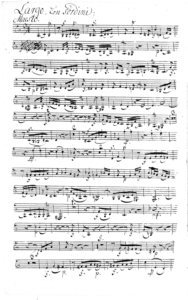Seeing with different eyes…
Later this month, I am to record CPE Bach’s wonderful concerto in A major, which exists in versions for cello, flute or keyboard. The absolute glory of the work is its deeply moving slow movement, a tragic aria marked to be played Largo e mesto (slowly and sadly). This movement certainly presents few obvious technical difficulties, on whichever instrument it is played; but it does throw up some interesting questions, which have to be addressed by the performers.
 The largo is crammed, right from the first bars of its opening tutti, with constantly alternating markings of forte and piano. The natural reaction to this is to make huge contrasts between the two, since that is what would be implied with such indications today. Unfortunately, this tends to sound (to me, anyway) rather like a herd of cows in simultaneous labour. It’s just not natural. (I get the same feeling, incidentally, from many performances of the minuet of Mozart’s G major string quartet, with its alternating f and p markings. Actually, there is supposed to be a connection to the labour of Mozart’s wife in that quartet; but not in that movement!)
The largo is crammed, right from the first bars of its opening tutti, with constantly alternating markings of forte and piano. The natural reaction to this is to make huge contrasts between the two, since that is what would be implied with such indications today. Unfortunately, this tends to sound (to me, anyway) rather like a herd of cows in simultaneous labour. It’s just not natural. (I get the same feeling, incidentally, from many performances of the minuet of Mozart’s G major string quartet, with its alternating f and p markings. Actually, there is supposed to be a connection to the labour of Mozart’s wife in that quartet; but not in that movement!)
So how should CPE’s indications be realised? Well, we are lucky in that we have a rather well-qualified adviser in this matter: CPE Bach himself. In his ‘Essay on the True Art of Playing Keyboard Instruments’, he describes his own p and f markings as ‘light to dark shadings’. He also advises harpsichordists, even when playing on two manuals (alternating between which is the only possible way to vary dynamics when playing single notes) that ‘only one manual should be used to play detailed changes of forte and piano’. So evidently he does not mean a huge dynamic shift between the two; he is merely stressing the shape of the phrase.
But another element that distracts the modern player, causing them to make uneasily sudden contrasts within the phrase, is that there are no indications of crescendo or diminuendo. Again, we have to see through CPE Bach’s eyes. There are NO such indications in the bulk of his music; only towards the end of his life did he introduce them, and then very sparingly. But that doesn’t mean that there are none required in the music! Give a singer a line such as the one in this largo and they will naturally lead from one dynamic to another; and there is no reason why an instrumentalist should not do the same. Of course, in much baroque and early classical music – even in the outer movements of this concerto – we find ‘terraced’ dynamics, where one jumps from one extreme to another without preparation, particularly in sequences and repeated phrases; but that really does not apply to a cantabile aria like this.
Another question is about ornamentation: how much should we do? There is a particular conundrum here for cellists and flautists, since the keyboard version of this concerto has quite a bit of decoration written into the score. We could take this on board; but I don’t think it’s necessary. Keyboard instruments cannot sustain long notes as cellists and flautists can, so they need to embellish. And for CPE Bach, vibrato was an ornament, so if we add some (tasteful!) vibrato, that means that we are already ornamenting. Maybe most significant is that CPE writes approvingly in the ‘Essay’ of a friend of his who sticks faithfully to the written score, and rather scathingly of another friend who adds ornaments right, left and centre. He also, unnervingly, advises us that any ornamentation ‘must always be at least as good as, if not better than, the original. ‘ Hmmm…quite a challenge…
But above all, I feel, it is vital that this movement be played with only sincere, natural expression, as one would sing it in the shower – taking note of CPE Bach’s markings, certainly, but only viewed (as best we can) through 18th-century eyes, not 21st. Then, instead of sounding strange and foreign, this movement should speak directly to the listeners’ hearts, as intended by the composer – and also, in fact, to the players’ hearts. To quote the great man himself again: ‘A musician cannot move others unless he too is moved. He must feel all the affects that he hopes to arouse in his audience.’ Amen.